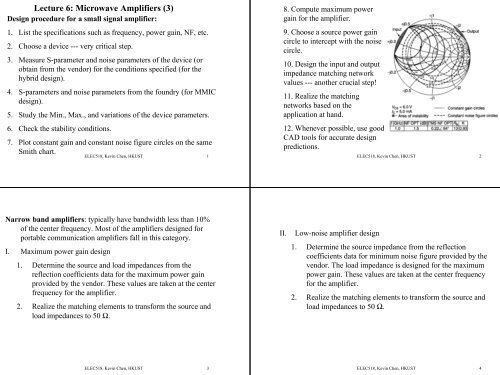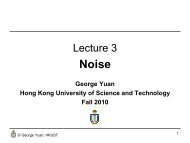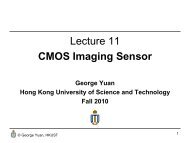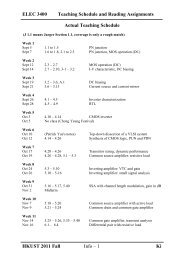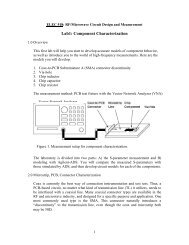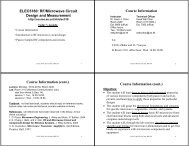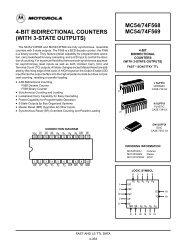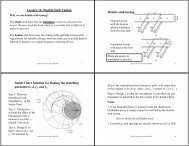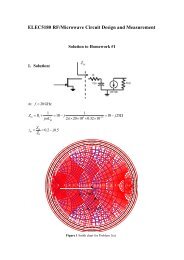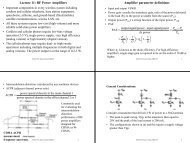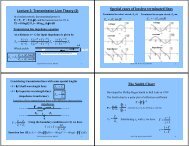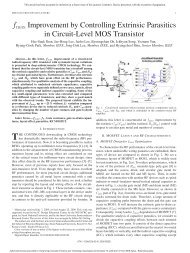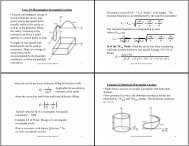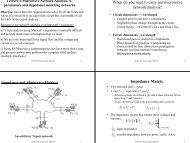Lecture 6: Microwave Amplifiers (3)
Lecture 6: Microwave Amplifiers (3)
Lecture 6: Microwave Amplifiers (3)
You also want an ePaper? Increase the reach of your titles
YUMPU automatically turns print PDFs into web optimized ePapers that Google loves.
<strong>Lecture</strong> 6: <strong>Microwave</strong> <strong>Amplifiers</strong> (3)<br />
Design procedure for a small signal amplifier:<br />
1. List the specifications such as frequency, power gain, NF, etc.<br />
2. Choose a device --- very critical step.<br />
3. Measure S-parameter and noise parameters of the device (or<br />
obtain from the vendor) for the conditions specified (for the<br />
hybrid design).<br />
4. S-parameters and noise parameters from the foundry (for MMIC<br />
design).<br />
5. Study the Min., Max., and variations of the device parameters.<br />
6. Check the stability conditions.<br />
7. Plot constant gain and constant noise figure circles on the same<br />
Smith chart.<br />
ELEC518, Kevin Chen, HKUST 1<br />
8. Compute maximum power<br />
gain for the amplifier.<br />
9. Choose a source power gain<br />
circle to intercept with the noise<br />
circle.<br />
10. Design the input and output<br />
impedance matching network<br />
values --- another crucial step!<br />
11. Realize the matching<br />
networks based on the<br />
application at hand.<br />
12. Whenever possible, use good<br />
CAD tools for accurate design<br />
predictions.<br />
ELEC518, Kevin Chen, HKUST 2<br />
Narrow band amplifiers: typically have bandwidth less than 10%<br />
of the center frequency. Most of the amplifiers designed for<br />
portable communication amplifiers fall in this category.<br />
I. Maximum power gain design<br />
1. Determine the source and load impedances from the<br />
reflection coefficients data for the maximum power gain<br />
provided by the vendor. These values are taken at the center<br />
frequency for the amplifier.<br />
2. Realize the matching elements to transform the source and<br />
load impedances to 50 Ω.<br />
II.<br />
Low-noise amplifier design<br />
1. Determine the source impedance from the reflection<br />
coefficients data for minimum noise figure provided by the<br />
vendor. The load impedance is designed for the maximum<br />
power gain. These values are taken at the center frequency<br />
for the amplifier.<br />
2. Realize the matching elements to transform the source and<br />
load impedances to 50 Ω.<br />
ELEC518, Kevin Chen, HKUST 3<br />
ELEC518, Kevin Chen, HKUST 4
Broadband Transistor Amplifier Design: Balance <strong>Amplifiers</strong><br />
III. Special considerations for monolithic RFIC circuit design:<br />
1. Try to minimize the space taken by passive components to<br />
reduce the die size (and therefore the cost).<br />
2. Element values limited by planar process.<br />
3. The design must be tolerant to the expected process<br />
variation of the active device parameters due to the lack of<br />
tuning capability.<br />
4. RFIC/MMIC design requires “yield-driven” approach,<br />
compared to the “performance-driven” approach of the<br />
hybrid IC design.<br />
ELEC518, Kevin Chen, HKUST 5<br />
Challenges for broadband transistor amplifiers:<br />
• Conjugate matching will give maximum gain only over a<br />
relatively narrow bandwidth.<br />
• Designing for less than maximum gain will improve the gain<br />
bandwidth, but the input and output ports of the amplifier will be<br />
poorly matched.<br />
• Gain rolloff of |S 21 | at a rate of 6 dB/octave.<br />
Some common approaches to design broadband amplifiers:<br />
• Compensated matching networks: frequency response of the<br />
matching network can compensate the gain rolloff in |S 21 | .<br />
• Negative feedback: flatten gain response, at the expense of gain<br />
and noise figure.<br />
• Balanced amplifiers: good matching, but the design is more<br />
ELEC518, Kevin Chen, HKUST 6<br />
complicated.<br />
Broadband Transistor Amplifier Design<br />
• <strong>Microwave</strong> transistors typically are not well matched in<br />
broadband amplifiers.<br />
• Broader bandwidth can be obtained at the expense of gain and<br />
complexity.<br />
Common approaches to achieving broader bandwidth<br />
Balance <strong>Amplifiers</strong><br />
Two amplifiers having 90 o couplers at their input and output can<br />
provide good matching over an octave bandwidth, or more. The<br />
gain is equal to that of a single amplifier, however, and the design<br />
requires two transistors and twice the DC power.<br />
• Compensated matching networks: matching networks can be<br />
designed to compensate for the gain rolloff in S21.<br />
• Resistive matching networks: better matching with a loss in gain<br />
and increase in noise figure.<br />
• Negative feedback: negative feedback can be used to flatten the<br />
gain response of the transistor at the expense of gain and noise<br />
figure.<br />
ELEC518, Kevin Chen, HKUST 7<br />
ELEC518, Kevin Chen, HKUST 8
How is the input and output mismatch improved in<br />
Balance <strong>Amplifiers</strong>?<br />
The input at each amplifier is given by<br />
1 V<br />
2<br />
j<br />
2 V<br />
+ VA<br />
1<br />
=<br />
+ − +<br />
1+<br />
V B 1<br />
=<br />
1<br />
The output is given by<br />
− − j + 1<br />
V2<br />
= VA2<br />
+ V<br />
2 2<br />
− j +<br />
= V1<br />
( GA<br />
+ GB<br />
)<br />
2<br />
+<br />
B2<br />
− j<br />
= GAV<br />
2<br />
+<br />
A1<br />
1<br />
GBV<br />
2<br />
+<br />
B1<br />
ELEC518, Kevin Chen, HKUST 9<br />
+<br />
S 21 of the overall amplifier is<br />
Overall gain of the balanced amplifier is the average of the<br />
individual amplifier.<br />
The total reflected voltage at the input can be written as<br />
V<br />
=<br />
−<br />
1<br />
1 − − j<br />
= VA<br />
1<br />
+ V<br />
2 2<br />
1 +<br />
V1<br />
( ΓA<br />
− ΓB<br />
)<br />
2<br />
−<br />
B1<br />
=<br />
−<br />
V2<br />
− j<br />
S = = ( G A<br />
+ G<br />
V +<br />
2<br />
21 B<br />
1<br />
1<br />
ΓAV<br />
2<br />
+<br />
A1<br />
− j<br />
+ ΓBV<br />
2<br />
1<br />
S 11 of the overall amplifier is ( )<br />
S<br />
V<br />
+<br />
B1<br />
ELEC518, Kevin Chen, HKUST 10<br />
1<br />
−<br />
11<br />
= = ΓA<br />
− ΓB<br />
V +<br />
1 2<br />
S11 is small as long as the two amplifiers are close in performance.<br />
)<br />
Advantages of balanced amplifiers<br />
Performance and Optimization of a Balanced Amplifier<br />
Pozar, p. 834-835.<br />
ELEC518, Kevin Chen, HKUST 11<br />
ELEC518, Kevin Chen, HKUST 12
Distributed <strong>Amplifiers</strong><br />
Operating principle<br />
• Old idea getting a new life.<br />
• Bandwidth in excess of a decade are possible, with good input<br />
and output matching.<br />
Configuration of an N-stage distributed amplifier.<br />
ELEC518, Kevin Chen, HKUST 13<br />
• The input signal propagates down the gate line, with each FET<br />
tapping off some of the input power.<br />
• The amplified output signals from the FETs form a traveling<br />
wave on the drain line.<br />
• The propagation constants and lengths of the gate and drain lines<br />
are chosen for constructive phasing of the output signals.<br />
• The termination impedances on the lines serve to absorb waves<br />
traveling in the reverse directions.<br />
• The gate and drain capacitances of the FET effectively become<br />
part of the gate and drain transmission lines, while the gate and<br />
drain resistances introduce loss on these lines.<br />
• Distributed amplifiers are also know as the traveling wave<br />
amplifiers (TWAs).<br />
ELEC518, Kevin Chen, HKUST 14<br />
Analysis: separate loaded transmission lines for gate and drain<br />
Transmission line circuit for the drain line.<br />
Transmission line circuit for<br />
the gate line.<br />
Equivalent circuit of a single<br />
unit cell of the gate line.<br />
ELEC518, Kevin Chen, HKUST 15<br />
ELEC518, Kevin Chen, HKUST 16
Gate transmission line analysis<br />
Z<br />
= jω<br />
L g<br />
Y<br />
= jωC<br />
g<br />
jωCgs<br />
/ lg<br />
+<br />
1+<br />
jωR C<br />
New characteristic impedance of the gate line is<br />
Z<br />
g<br />
=<br />
The attenuation is:<br />
γ = α + jβ<br />
=<br />
g<br />
g<br />
g<br />
Z<br />
Y<br />
ZY<br />
=<br />
=<br />
C<br />
g<br />
L<br />
g<br />
+ C<br />
gs<br />
/ l<br />
g<br />
⎡<br />
jωLg<br />
⎢ jωC<br />
⎢⎣<br />
g<br />
i<br />
gs<br />
jωCgs<br />
/ l<br />
+<br />
1+<br />
jωR C<br />
i<br />
g<br />
gs<br />
⎤<br />
⎥<br />
⎥⎦<br />
Drain transmission line analysis<br />
ELEC518, Kevin Chen, HKUST 17<br />
ELEC518, Kevin Chen, HKUST 18<br />
Gain of a distributed amplifier:<br />
ELEC518, Kevin Chen, HKUST 19<br />
ELEC518, Kevin Chen, HKUST 20
Power Dividers and Directional Couplers<br />
• Passive components used for power division or power<br />
combining<br />
• In the form of three-port (T-junction) networks and fourport<br />
(directional) networks<br />
Reference: Y. Ayasli, et al.<br />
IEEE Trans. <strong>Microwave</strong> Theory and<br />
Techniques, vol. 30, pp. 976-981, July<br />
1982.<br />
ELEC518, Kevin Chen, HKUST 21<br />
Basic Properties of Dividers and Couplers<br />
Three-Port Networks (T-Junctions)<br />
It would be useful to have a passive lossless network that<br />
divides input port power at any port between the other<br />
two ports while being matched at all three ports. This<br />
would require the network to be matched, lossless and<br />
reciprocal.<br />
ELEC518, Kevin Chen, HKUST 22<br />
Network S-matrix<br />
(1) Matched S ii = 0<br />
(2) Lossless Unitary [S]<br />
(3) Reciprocal<br />
Symmetric [S]<br />
0 S 12 S 13<br />
[S] = S 21 0 S 23<br />
S 31 S 32 0<br />
This matrix can satisfy (1)<br />
and (3), but not (2).<br />
Therefore, using “normal” lossless components such as<br />
transmission lines, capacitors and inductors it is impossible to<br />
construct a 3-port network matched at all 3 ports.<br />
Need to relax one of the restrictions.<br />
A. For a nonreciprocal 3-port network (S ij ≠ S ji ), using<br />
anisotropic materials (such as ferrite), all ports can be<br />
matched and a circulator is created.<br />
Two Types of Circulators<br />
(1) Clockwise circulation<br />
0 0 1<br />
[S] = 1 0 0<br />
0 1 0<br />
it rotates power from port 1->2, port 2->3 and port 3->1.<br />
(2) Clockwise circulation<br />
0 1 0<br />
[S] = 0 0 1<br />
1<br />
1 0 0<br />
it rotates power from port 1->2, port 2->3 and<br />
port 3->1.<br />
1<br />
2<br />
3<br />
2<br />
3<br />
ELEC518, Kevin Chen, HKUST 23<br />
ELEC518, Kevin Chen, HKUST 24
Applications of Circulators:<br />
• Protects a power amplifier from output mismatch.<br />
• Allows a transmitter and receiver to share an antenna.<br />
B. For a lossless and reciprocal 3-port network (S ij = S ji ),<br />
but with only two ports matched.<br />
0 S 12 S 13<br />
[S] = S 12 0 S 23<br />
S 13 S 32 S 33<br />
The requirement for unitary<br />
matrix leads to<br />
0 e jθ 0<br />
[S] = e jθ 0 0<br />
0 0 e jφ<br />
Totally mismatched<br />
ELEC518, Kevin Chen, HKUST 25<br />
C. For a reciprocal and all-matched 3-port network (S ij =<br />
S ji ), but with lossy components.<br />
This is the case of the resistive divider. A lossy 3-port<br />
network can be made to have isolation between its output<br />
ports.<br />
Four Port Networks (Directional Couplers)<br />
Pozar’s book shows that a matched, reciprocal, lossless four-port<br />
network is possible, and that it has directional coupling between<br />
pairs of ports.<br />
There are two possible forms of [S] for a directional coupler, one<br />
with outputs differing by 90° in phase and the other with outputs<br />
differing by 180° in phase. Any 90° coupler can be made into a<br />
180° coupler by adding a 90° transmission to one port, and vice<br />
versa.<br />
ELEC518, Kevin Chen, HKUST 26<br />
Input<br />
Isolated<br />
1<br />
4<br />
⎡ 0<br />
⎢<br />
α<br />
[ S]<br />
= ⎢<br />
⎢ jβ<br />
⎢<br />
⎣ 0<br />
90°<br />
Coupler<br />
α<br />
0<br />
0<br />
jβ<br />
0<br />
0<br />
α<br />
2<br />
3<br />
jβ<br />
90°<br />
0 ⎤<br />
jβ<br />
⎥<br />
⎥<br />
α ⎥<br />
⎥<br />
0 ⎦<br />
Output<br />
Coupled<br />
2 2<br />
α + β = 1<br />
Σ<br />
∆<br />
1<br />
4<br />
⎡0<br />
⎢<br />
α<br />
[ S]<br />
= ⎢<br />
⎢β<br />
⎢<br />
⎣0<br />
180°<br />
Hybrid<br />
− β<br />
180°<br />
Output<br />
Output<br />
ELEC518, Kevin Chen, HKUST 27<br />
α<br />
0<br />
0<br />
2<br />
3<br />
β 0 ⎤<br />
0 − β<br />
⎥<br />
⎥<br />
0 α ⎥<br />
⎥<br />
α 0 ⎦<br />
Any 90° coupler can be made into a 180° coupler by adding a<br />
90° transmission to one port, and vice versa.. The 90° coupler is<br />
referred to as a quadrature hybrid, and can be created using directly<br />
connected branch lines between two transmission lines or by means<br />
of coupled transmission lines.<br />
Input<br />
Isolated<br />
1<br />
Zo<br />
4<br />
λ/4<br />
Zo/¦2<br />
2<br />
λ/4<br />
3<br />
Output<br />
Output<br />
Coupled<br />
A branch-line coupler A coupled-line<br />
directional coupler<br />
Coupling, Directionality and Isolation<br />
Input<br />
Coupling = C = 10log(P1/P3) = -20logβ dB<br />
Directivity = D = 10 log (P3/P4) = 20logβ/ |S 14 |dB<br />
Isolation = I = 10log(P1/P4) = -20log |S 14 |dB<br />
I= D + C dB<br />
Isolated<br />
Through<br />
ELEC518, Kevin Chen, HKUST 28
Resistive Divider<br />
If we relax the requirement for zero loss,<br />
we can realize a matched, reciprocal<br />
power divider.<br />
Such a divider<br />
can be realized<br />
by connecting<br />
three Zo<br />
transmission<br />
lines to a star<br />
circuit consisting<br />
of three resistors<br />
R = Z o /3.<br />
An equal-split three-port<br />
resistive power divider.<br />
The impedance looking into the resistor<br />
followed by the output line, is<br />
Z0 4Z<br />
Z = + Z0<br />
=<br />
3 3<br />
ELEC518, Kevin Chen, HKUST 29<br />
0<br />
The input impedance of the divider is<br />
Z<br />
3<br />
2Z<br />
3<br />
0 0<br />
Z in<br />
+ =<br />
= matched<br />
Since the network is symmetric from all three ports, the<br />
output ports are also matched.<br />
Output Power<br />
The output voltage from port 2 and 3 are,<br />
Z<br />
0<br />
V1<br />
V<br />
2<br />
= V3<br />
=<br />
2<br />
Thus, S 21 = S 31 = S 23 = 1/2, which indicates -6 dB below<br />
the input power level. We have<br />
⎡0<br />
1 1⎤<br />
1<br />
1<br />
⎢ ⎥ Port 2 and 3 are<br />
[S]<br />
= 1 0 1<br />
P2 = P3<br />
= Pin<br />
2 ⎢ ⎥ not isolated.<br />
4<br />
⎢⎣<br />
1 1 0⎥⎦<br />
power<br />
ELEC518, Kevin Chen, HKUST 30<br />
The Wilkinson Power Divider<br />
Motivation: to solve the problem of output isolation<br />
The Wilkinson power divider is a three-port that has all ports<br />
matched with isolation between the two output ports.<br />
An equal-split Microstrip Wilkinson Equivalent circuit<br />
power divider<br />
The Wilkinson power divider can be made to give arbitrary<br />
power division. But an equal-split one is used here for<br />
analysis.<br />
ELEC518, Kevin Chen, HKUST 31<br />
Features of the Wilkinson dividers<br />
1. By choosing the impedance of the λ/4 lines to be 2 Z o , the<br />
matched output loads Z L = Z o are transformed to 2Z o so they can be<br />
placed in parallel to equal 2Z o /2 = Z o creating a matched condition at<br />
the input port.<br />
2. Any mismatched power returned from a load at either output port is<br />
divided equally between the load on the input port (the generator<br />
source impedance, presumed to be Z g = Z o ) and the resistor R.<br />
3. None of the reflected power from a mismatched load is dissipated<br />
in the other load, so the output ports are isolated (S 23 = S 32 = 0).<br />
When the Wilkinson power divider is driven at port 1 and the<br />
outputs are matched, no power is dissipated in the resistor. Thus the<br />
divider is lossless when the outputs are matched; only reflected<br />
power from ports 2 or 3 is dissipated in the resistor. Since S 23 = S 32<br />
= 0, ports 2 and 3 are isolated.<br />
ELEC518, Kevin Chen, HKUST 32
S-parameters of a Wilkinson divider<br />
S = 0<br />
0<br />
11<br />
S = S<br />
22 33<br />
=<br />
The (4-port) Directional Couplers<br />
• A fraction of a wave<br />
traveling from port 1 to port<br />
2 via the transmission line<br />
1-2 is coupled to port 3, but<br />
not to port 4.<br />
• A fraction of a wave<br />
traveling from port 2 to port<br />
1 is coupled to port 4, but<br />
not to port 3.<br />
• The same coupling exists in<br />
transmission line 1-2 for<br />
waves traveling on line 4-3.<br />
S<br />
e o<br />
1 1<br />
12<br />
= S21<br />
=<br />
e o<br />
V2<br />
+ V S23 = S32<br />
= 0<br />
2<br />
= − j /<br />
V<br />
2<br />
+ V<br />
Symbols for directional couplers.<br />
ELEC518, Kevin Chen, HKUST 33<br />
Recalling the definition of Coupling, Directivity and<br />
Isolation factors.<br />
C and D can be measured directly, but the<br />
Coupling = C =10log(P 1 /P 3 ) power level at the coupled ports (3 and 4)<br />
may be small enough to make this<br />
Directivity = D = 10 log(P 3 /P 4 ) difficult, particularly if the signal coupled<br />
Isolation = I = 10log(P 1 /P 4 ) from the input to reverse output port 4 is<br />
masked by a reflected wave from an<br />
imperfectly matched load at port 2.<br />
The Quadrature (90 O ) Hybrid Directional<br />
Couplers<br />
• A 3 dB directional coupler with a 90 o phase difference in the<br />
outputs of the through and coupled arms.<br />
• Exist in the form of branch-line, coupled line and or Lange<br />
(interdigitated).<br />
ELEC518, Kevin Chen, HKUST 34<br />
Brach-Line Couplers<br />
Highly symmetric<br />
A branch-line coupler in<br />
normalized form<br />
B = 0 1<br />
(port 1is matched)<br />
j<br />
o<br />
B2<br />
= − (half - power, - 90 phase shift from port 1 to 2)<br />
2<br />
B3 = −<br />
1 o<br />
2<br />
(half - power, -180<br />
phase shift from port 1 to 3)<br />
⎡0<br />
⎢<br />
−1<br />
j<br />
The [S] matrix is given by [ S]<br />
= ⎢<br />
2 ⎢1<br />
⎢<br />
⎣0<br />
A practical microstrip quadrature<br />
hybrid prototype.<br />
Some practical design issues:<br />
1. Limited bandwidth: due to the nature<br />
of quarter-wave line. Multisection design<br />
will help.<br />
2. The effect of discontinuity at the<br />
junctions: shunt arms are usually<br />
lenghthened by 10 o -20 o .<br />
B = 0 4<br />
(no power to port 4)<br />
ELEC518, Kevin Chen, HKUST 35<br />
ELEC518, Kevin Chen, HKUST 36<br />
j<br />
0<br />
0<br />
1<br />
1<br />
0<br />
0<br />
j<br />
0⎤<br />
1<br />
⎥<br />
⎥<br />
j⎥<br />
⎥<br />
0⎦
Coupled Line Theory<br />
Various geometries<br />
Edge-coupled stripline Broadside-coupled stripline<br />
Edge-coupled microstrip line.<br />
Even mode excitation: E-field symmetric about the center line<br />
C 12 is opencircuited<br />
C e =C 11 = C 22 ,<br />
assuming the<br />
two strips are<br />
identical in size<br />
and location.<br />
Z<br />
L<br />
LC<br />
e<br />
0e = = =<br />
Ce<br />
Ce<br />
1<br />
vC<br />
Odd mode<br />
where v is the propagation velocity on the line.<br />
excitation C o =C 11 + 2C 12 = C 22 + 2C 12<br />
e<br />
,<br />
Equivalent circuit<br />
ELEC518, Kevin Chen, HKUST 37<br />
Z<br />
0 e<br />
=<br />
1<br />
vC<br />
o<br />
Voltage null<br />
ELEC518, Kevin Chen, HKUST 38<br />
Tight Couplers: The Lange Couplers and Ring<br />
Hybrid Couplers<br />
• Coupled-line couplers are not suitable to achieve coupling factors of<br />
3 dB or 6 dB, due to the loose coupling.<br />
• Tight coupling can be achieved by the special layout of the coupled<br />
lines, so that the fringing fields at the edge of the lines can contribute<br />
to the coupling.<br />
The Lange Couplers:<br />
The interdigitated Lange coupler The unfolded Lange coupler<br />
ELEC518, Kevin Chen, HKUST 39<br />
The Lange couplers has the following features:<br />
• There is a 90 o phase difference between the output lines (ports 2 and 3)<br />
• Difficult to fabricate the bonding wires due to the narrow spacing between<br />
the lines.<br />
The 180 o Hybrid<br />
• The two outputs are either in phase<br />
or with a 180 o phase difference.<br />
• A signal applied to port 1 is evenly<br />
divided into two in-phase<br />
components at port 2 and 3, with port<br />
4 isolated.<br />
• A signal applied to port 4 is equally<br />
split into two out-of-phase<br />
components at port 2 and 3, with port<br />
1 isolated.<br />
⎡0<br />
⎢<br />
− j 1<br />
[ S]<br />
= ⎢<br />
2 ⎢1<br />
⎢<br />
⎣0<br />
−1<br />
0 ⎤<br />
−1<br />
⎥<br />
⎥<br />
1 ⎥<br />
⎥<br />
0 ⎦<br />
ELEC518, Kevin Chen, HKUST 40<br />
1<br />
0<br />
0<br />
1<br />
0<br />
0<br />
1
• When operated as a combiner, with inputs at ports 2 and 3, the sum of<br />
the inputs will be formed at port 1 (the sum port), while the difference<br />
will be formed at port 4 (the difference port).<br />
Ring Hybrid (rat-race): a typical 180 o Hybrid<br />
Port 3<br />
Port 1<br />
Port 4<br />
Port 2<br />
Similar to branch-line coupler. Can be easily constructed in<br />
planar (microstrip or stripline) form. Read pp. 403-407 of Pozar.<br />
ELEC518, Kevin Chen, HKUST 41


